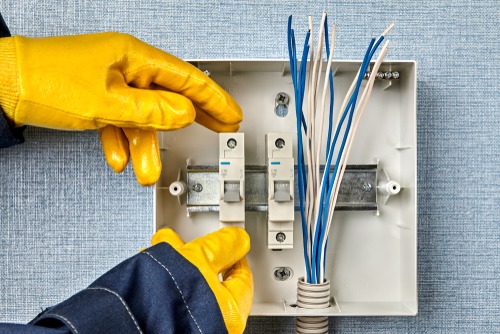Wear and tear takes a toll on homes, and periodic maintenance and repair is required. Your wiring is no exception. Wiring in old homes can be exposed to a number of hazards including rodents, moisture, and renovations. Damaged wiring creates electrical and fire hazards. Since your wiring is hidden behind walls, troubleshooting wear and tear electrical issues can be daunting. The best way to protect yourself against such hazards is to know the signs that a problem exists. Here are some common indicators that an electrical component of your home needs to be rewired.
1. Outlet problems
Discolored outlets are an indication of a loose connection in the outlet box. Loose wiring poses a great risk to your home. When wires aren’t properly connected, the electricity will arc -creating sparks, an odd burning smell, and scorch marks. If there are small burn marks around electrical outlets in your home, then most likely there is a loose connection in those outlets that needs to be addressed.
Another common item in your home that needs rewiring are switches. Over time both switches and outlets can become loose, pulling away from the wall and exposing wires. If there are loose switches or outlets hanging on the wall in your home, they should be replaced. As with all electrical work, you should hire a licensed electrician do the wiring and troubleshooting. Perhaps one that also provides HVAC services in Montgomery County PA.
2. Electric shock
No one wants to be electrocuted, especially since it can lead to health issues, possibly even death. This is why it is important to pay attention if you ever receive an electrical shock when using an outlet or switch. If you do receive a shock, you should immediately unplug any appliances and inspect their cords for breaks. These breaks won’t just shock you, but can also cause fires. If the shock didn’t come from the appliance, but rather the outlet or switch, contact an electrician to inspect the device and safely rewire it.
3. Flickering lights
A number of issues can cause lights to flicker. If the flickering lights are localized to a single fixture, the best spot to start is by making sure the bulb is twisted in properly. At the same time, verify that the lamp socket is rated to handle the wattage of the bulb you are using.
If this doesn’t work, then it is time to have a qualified electrician inspect the lighting fixture and wiring. They will know how to look for loose connections and short circuits in the wiring. Once found, these issues can be repaired, solving the flickering lights and protecting your family from hidden electrical hazards.
Homes with overhead electrical service may experience lights flickering throughout the home during periods of high wind. This is caused by a bad connection between your home’s wiring and the wires from the utility company. In this situation, contact the utility company and find out whose responsibility these connections are. Quite possibly you will need to coordinate between the utility company and a qualified electrician to have the connection properly repaired.
4. Circuit breaker trips a lot
Circuit breakers are your first line of defense against short circuits and circuit overload. Under normal circumstances they should not trip. If one is routinely tripping, it is best to identify the reason.
First, do you have too many items plugged into the circuit? Having a circuit overloaded can not only cause the circuit to trip, but also present a fire hazard. If the circuit is overloaded, it is best to either have an electrician to rewire the circuit to handle more load, or split the circuit into two separate circuits.
If the circuit is tripping as soon as something is plugged in, then you probably have a short circuit. There are numerous reasons for short circuits, including loose wires and damage that is hidden behind the walls. With our AC repair services in Doylestown, Bergey’s HVAC has experience tracking down both electrical and HVAC problems that are hidden in your home.
5. The home has aluminum wiring
During the 1960’s and 1970’s the price of copper wire soared. This caused many people to turn to aluminum wire for their home’s wiring. Unfortunately, the unique properties of aluminum that saved homeowners money, also created fire hazards in their home. In fact according to safety experts, its tendency to overheat and make poor connections means that aluminum wire more than doubles the risk of fire. If your home was built between the early 1960’s and late 1970’s, you should check to see if it is wired with aluminum. If so, it is advisable to replace the aluminum with new copper wire.
Whatever the cause, electrical problems should be taken seriously. If you believe there is an issue with your home’s wiring then the first step in keeping your home safe is to consult an experienced contractor in Hatfield PA.

